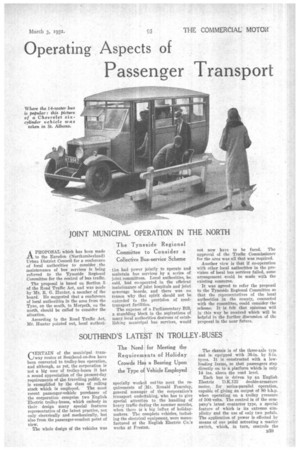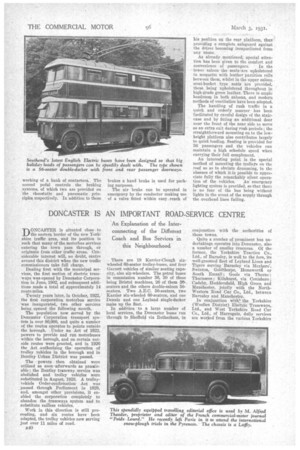SOUTHEND'S LATE T IN TROI I.F.Y-BUSES
Page 57

Page 58

If you've noticed an error in this article please click here to report it so we can fix it.
CERTAIN of the municipal tramway routes at Southend-on-Sea have been converted to trolley-bus operation, and although, as yet, the corporation is not a big user of trolley-buses it has a sound appreciation of the present-day requirements of the travelling public, as is exemplified by the class of rolling stock which is employed. The most recent passenger-vehicle purchases of the corporation comprise two English Electric trolley-buses, which embody in their design many special features representative of the latest practice, not only electrically and mechanically, but also from the passenger-comfort point of view.
The whole design of the vehicles was specially worke ouC4to meet the requirements of Mr. Ronald Fearnley, general manag r of the corporation's transport uncle eking. who has to give special attenti a to the handling of heavy traffic du 'iag the summer months,
when there is big influx of holidaymakers. The complete vehicles, including the electrical equipment, were manufactured at the English Electric Co.'s works at Preston. The chassis is of the three-axle type and is. equipped with 36-in. by 8-in. tyres_ It is constructed with a lowloading frame, so that passengers step directly on to a platform which is only 14 ins, above the road level.
Each bus is driven, by an English Electric DIC.122 double-armature motor, for series-parallel operation, capable of giving an output of 80 b.h.p. when operating on a trolley pressure of 500 volts. The control is of the company's latest contactor type, a special feature of which is its extreme simplicity and the use of only two pedals. The application of power is effected by means of one pedal actuating a master switch, which, in turn, controls the
working of a bank of contactors. The second pedal controls the braking systems, of which two are provided on the rheostatic and pneumatic principles respectively. In addition to these brakes a hand brake is used for parking purposes.
The air brake can be operated in emergency by the conductor making use of a valve fitted within easy reach of his position on the rear platform, thus' providing a complete safeguard against the driver becoming incapacitated from any cause.
As already mentioned, special attention has been given to the comfort and
convenience of passengers. In the loiver saloon the seats! are upholstered in moquette with leather partition rolls between them, whilst in the upper saloon semi-bucket type seats are provided, these being upholstered throughout in high-grade green leather. There is ample headroom in both saloons, and modern methods of ventilation have been adopted.
The handling of rush traffic in a quick and orderly manlier has been facilitated by careful design of the staircase and by fitting an additional door near the front of the near side to serve as an extra exit during rush periods ; the straightforward mounting on to the low-, height platform also contributes largely to quick loading. Seating is provided for 56 passengers and the vehicles can maintain a high schedule speed when carrying their full complement.
An interesting point is the special method of mounting the trolleys on the roof so as to obviate drumming, in the absence of which it is possible to appreciate fully the remarkably silent opera tion of the vehicles. An emergency lighting system is provided, so that there is no fear of the bus being without lights in the event of the supply through the overhead lines failing.




































































































